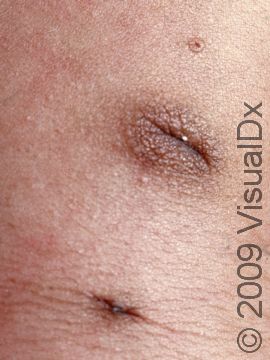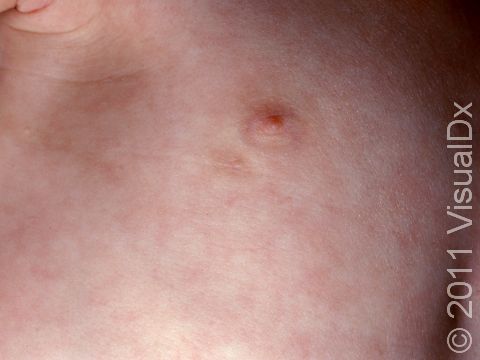Supernumerary Nipple
Supernumerary nipple is the medical term to describe the presence of one or more extra nipples present on a person’s body. They are harmless and occur in 1%-6% of people worldwide. Supernumerary nipples are present at birth but may not become noticeable until childhood or later in life.
Who's At Risk?
Anyone can be born with one or more supernumerary nipples. They are slightly more common in males than females. If not noticeable at birth, they may become darker during adolescence or at menstruation or during pregnancy. It is thought that supernumerary nipples may occur within families.
Signs & Symptoms
A supernumerary nipple appears as a pink, tan, or brown papule (a small, raised bump) on the abdomen, typically in-line with the normal nipple. Occasionally the papule looks distinctly nipple-like, with a small dimple in the middle and a lighter surrounding area that resembles the areola (the pigmented area around the nipple). Very rarely there is breast tissue present underneath the supernumerary nipple. There may be multiple supernumerary nipples, such as one on each side of the body or two or more extending in a vertical line down the abdomen on one side, anywhere from the underarm to the upper thigh. Supernumerary nipples are usually not itchy or painful, but occasionally they may become swollen or tender.
Self-Care Guidelines
No self-care is needed for a supernumerary nipple.
Treatments
The medical professional will examine the supernumerary nipple and may recommend routine examination. No treatment is needed, but if removal is wanted for cosmetic purposes, the medical professional may offer information about surgical removal.
Visit Urgency
There is no need to seek medical care for a supernumerary nipple. However, if there is a cosmetic concern, see a medical professional such as a dermatologist or surgeon to ask about options for removal. In the case of a supernumerary nipple in a baby, it would make sense to wait until the baby has reached middle childhood to see if the nipple naturally becomes less obvious, rather than seek surgical care in infancy.
Trusted Links
References
Bolognia J, Schaffer JV, Cerroni L. Dermatology. 4th ed. Philadelphia, PA: Elsevier; 2018.
James WD, Elston D, Treat JR, Rosenbach MA. Andrew’s Diseases of the Skin. 13th ed. Philadelphia, PA: Elsevier; 2019.
Kang S, Amagai M, Bruckner AL, et al. Fitzpatrick’s Dermatology. 9th ed. New York, NY: McGraw-Hill Education; 2019.
Paller A, Mancini A. Paller and Mancini: Hurwitz Clinical Pediatric Dermatology. 6th ed. St. Louis, MO: Elsevier; 2022.
Last modified on October 13th, 2023 at 9:55 am

Not sure what to look for?
Try our new Rash and Skin Condition Finder

